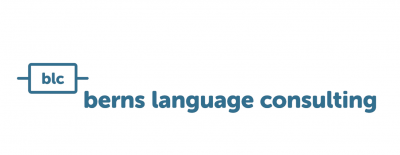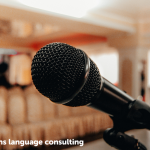Did you read the blog my colleague Jenny has written last week with as much excitement as I did?
My terminology heart was definitely leaping for joy while reading about the current developments of ontological terminology management!
Furthermore, this is exactly the right reason for me to add a few words here.
Here’s why: Anyone who remembers knows that just a little more than three years ago – where did the time go?! – I wrote my master thesis on almost exactly this topic.

More specifically, it was about the synergies between terminology and ontology.
Ontologies were already on the rise “back then”, and they are essential in the current heated discussions about AI and Large Language Models (LLMs) .
More and more people and businesses are recognizing the importance – not only – of terminology for AI applications, but also of AI applications for terminology!
That’s why I’d like take a look back on the topic of my master thesis and tell you what has been happening there since then. Enjoy!
Miniature Review Of My Master Thesis
The focus: Synergies between terminology and ontology in the age of the Semantic Web – influence and importance of terminological structures on ontology management.
The question: At which point and how do terminology and ontology come together?
Where can one find synergies between these two disciplines, that are interrelated but that have been considered primarily separated from each other?
How can terminology be used for building ontologies and why is it important as a basis?
The realization: Investigation of ontological processes and an ontology itself for existing or missing terminological influences, taking into account the practical utilization of terminology and ontologies.
Still Exciting: Benefits & Implementation Of Ontologies
As a subdomain of artificial intelligence (AI), ontologies are one of the largest pillars, on which knowledge management and the Semantic Web rely.
Roughly speaking, they are primarily used to improve communication between human and machine, as they provide information in a way that enables it to be processed by machines.
However, they are mostly important for the presentation of interconnected knowledge.
Ontologies take terminology data and purposefully use it in a machine-readable format (e.g. RDF and OWL). Thus, if ontologies are built directly on clearly defined and accepted terminology, they can efficiently organize, relate and distribute knowledge.
Some examples for this are chatbots, semantic searches, knowledge-based counselling and assistance systems or systematic support for terminologists in building up their termbases – this just to name a few, there are many more exciting use cases to be looked at as well!
And of course, that is not the end of the story.
Every company can efficiently use ontologies in different ways (something we would be happy to advise you on!).
Synergies, But Where And For What Purpose?
Even when I wrote my master thesis, I realized that there are far more connections between terminology and ontologies than one would have guessed.
This is how, for example, the respective main components of terminology and ontology correspond to each other: classes, instances and properties in ontologies can be seen as the respective counterparts of superordinate concepts, subordinate concepts and relations in terminology.
However, this is only the tip of the iceberg. If you go deeper into the structure, you can also recognize many elements in the formal representation of ontologies (RDF, OWL) that can also be found, for example, in terminology databases (TBX, MultiTerm XML, etc.).
In spite of different orientations – formal semantics vs. linguistic specification – there is a significant connection that can be recognized very quickly and which helps to master the two disciplines.
Not only the elements and structure can be compared, but also the processes in terminology and ontology management themselves. When examined in more detail, they do follow similar paths.
Of course, there is no ONE process for all, but if you look at exemplary processes and the respective process steps, you discover some interesting phenomena.
The processes are similar in the first half when it comes to defining the domain, concepts/classes, individual concepts/instances, and relations/properties.
From there, however, the paths differ .
From Terminology To Ontology
While in terminology the management, control, and maintenance of the specified terminology data begin, ontologies continue with search queries to the database and making conclusions using axioms.
By accessing the stored data, specific queries are answered automatically, taking into account the semantic meaning.
Depending on the field of expertise and if the ontologies are interoperable, several of them can even be linked together in semantic applications to obtain an even greater range of knowledge.
Based on this, axioms (truths or rules) can then be used in ontologies to structure knowledge and draw conclusions from it.
The various types of axioms lay down rules within the ontology that help to derive implicit knowledge from the knowledge explicitly defined in the ontology.
In the age of the Semantic Web ontologies, by their very nature, are a far more powerful tool than terminology alone.
And yet they need terminology as it is one of the most important pillars of knowledge that ontologies benefit from.
And What About Today?
Practice shows that both now and then ontology systems can also completely stand alone and take terminology management, if at all, only complementary into account in their environment.
Still, the ontology system also requires the creation and maintenance of all systematic and structural relationships between the individual components in a correct and usable manner.
Nevertheless, it is still true today that ontologies can benefit greatly from a clean terminology basis.
Especially with the rapid increase in the significance of AI and LLMs, which we are currently experiencing and which makes organized bodies of knowledge indispensable. Only in this way terminology can be useful for AI.
However, terminology also benefits from AI just the same.
We already see several use cases in which AI is used to support – with limitations – for example the creation of definitions, population of metadata, identification of synonyms or the extraction of new terms. Moreover, optimization potentials can also be identified and rectified.
So, it still remains exciting to see which new directions and findings will emerge.
Nonetheless, the professional eye of terminologists remains vital and will remain an integral part of the automation-driven world in the future.
Curious?
Do you want to bring your corporate terminology into a green line, find the optimal terminology process for you and find out how you can benefit from the synergies between terminology and ontology in your company?
Or maybe you are a step further ahead, want to make the most of your clean terminology by using AI applications and find out what you can do with AI applications for your terminology?
Get in touch!
We will be happy to advise you and together we will find the best solution for you. And keep your eyes open: We may have planned something exciting about terminology and AI







